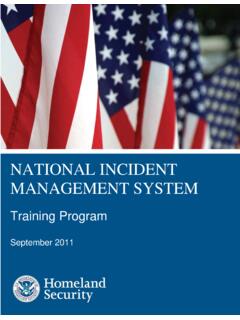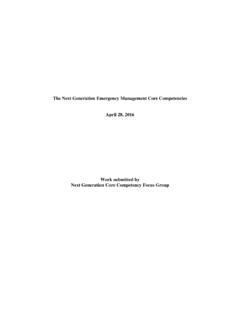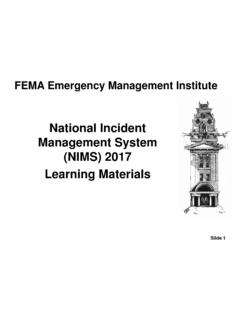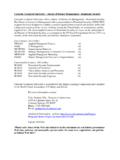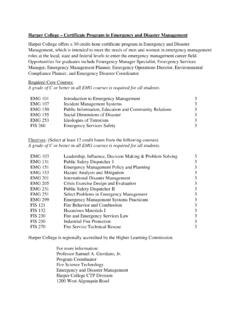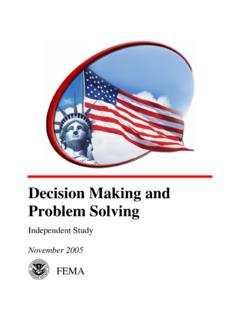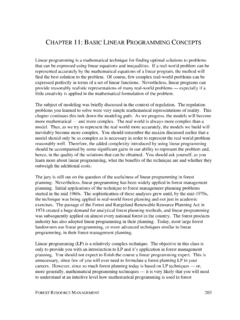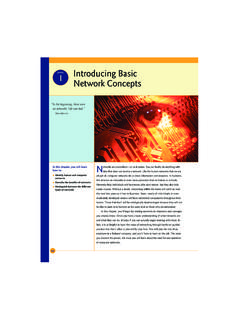Transcription of GUIDE TO EMERGENCY MANAGEMENT AND RELATED …
1 10/27/08 1 GUIDE TO EMERGENCY MANAGEMENT AND RELATED TERMS, DEFINITIONS, CONCEPTS, ACRONYMS, ORGANIZATIONS, PROGRAMS, GUIDANCE, EXECUTIVE ORDERS & LEGISLATION A Tutorial on EMERGENCY MANAGEMENT , Broadly Defined, Past and Present 2007 B. Wayne Blanchard B. Wayne Blanchard, , CEM October 22, 2008 (Date of Last Modification) Not until terms and concepts have been clearly defined can one hope to make any progress in examining the question clearly and simply and expect the reader to share one s views. (Carl Von Clausewitz, On War, Princeton University Press, 1976, p. 132) NOTE: This is not a comprehensive, definitive, exhaustive or official treatment of EMERGENCY MANAGEMENT and RELATED terms, definitions, acronyms, programs or legislation. It is simply a collection of terms, definitions, acronyms, and program and legislative descriptions and pulled together into a single document as time and opportunity have allowed to be assembled.
2 The original EMERGENCY MANAGEMENT - RELATED Terms and Definitions GUIDE was developed as a student handout in an Introduction to EMERGENCY MANAGEMENT college course taught by the author in 1999 and has been maintained as time allows for the authors own purposes, one of which is to continue supporting collegiate EMERGENCY MANAGEMENT courses. Another is as an aid to quickly accessing hard-to-remember terms, definitions and acronyms, etc., particularly when not used on a regular basis. At the time of original development the primary purpose was to demonstrate to the students the very wide range of definitions and meanings given to such words as hazards, disasters, emergencies, risk, vulnerability, and EMERGENCY MANAGEMENT . In the classroom productive time was spent trying to come to a group consensus on the variables comprising a definition of each word. The thought then and now was that words make a difference and that an indicator of a profession and of professionalism is a shared understanding of (better yet, general consensus on) key terms, definitions, concepts and principles that are part of a body of knowledge for a profession.
3 A shared understanding of key terms, definitions, concepts and principles is also a constituent element for the development of the academic discipline of EMERGENCY MANAGEMENT . The reception by EMERGENCY MANAGEMENT collegiate faculty and students (as well as EMERGENCY MANAGEMENT Professionals), over time, was such that a decision was made to expand the scope of the handout into other, mostly specific, EMERGENCY MANAGEMENT and RELATED terms and definitions. 10/27/08 2 After the creation of the Department of Homeland Security, and FEMA s incorporation into the DHS, the scope broadened again and also changed to incorporate references to relevant legislation, programs and organizations. More recently, as discussion of the development of international principles of disaster/ EMERGENCY MANAGEMENT seems to have gained momentum, a modest effort has been extended to the incorporation of international terms and definitions, particularly those originating from hazards- RELATED United Nations organizations and bodies.
4 Note 1: Obsolete and historical terms, definitions, etc. are included as an aid to understating such terms when encountered. Note 2: A bibliography of sources cited is at that the end of the document. All within-text citation sources have been included in this bibliography. Note 3: Use of this material for educational and professional purposes is unrestricted provided that proper attribution is provided. Terms, Definitions, Acronyms, Programs, Concepts, Organizations, Guidance, Legislation Alphabetically Organized Full References at the End A Zone: A Zone is defined as the Special Flood Hazard Area shown on a community s Flood Insurance Rate Map. The A Zone is the area subject to inundation during a 100-year flood, which is the flood elevation that has a 1-percent chance of being equaled or exceeded each year. There are several categories of A Zones, including AO (shallow sheet flow or ponding; average flood depths are shown); AH Zones (shallow flooding; base flood elevations are shown); numbered A and AE Zones (base flood elevations are shown); and unnumbered A Zones (no base flood elevations are provided because detailed hydraulic analyses were not performed).
5 (FEMA, Reducing Damage from Localized Flooding A GUIDE for Communities (FEMA 511), 2005, vii) AAC: After Action Conference, HSEEP. (FEMA, About HSEEP, 2008) AAC: Applicant Assistance Center. (FEMA, FAAT List (FEMA 524), 2005, p. 1) AAR: After Action Report. (DHS, TCL, 2007, p. 30) AAR: After Action Review. (Dept. of Army, WMD-CST Operations, Dec. 2007, Glossary 1) AAR/IP: After Action Report/Improvement Plan. (FEMA, About HSEEP, 2008) ABCP: Associate Business Continuity Planner, DRII. ABM: Anti-Ballistic Missile. 10/27/08 3 ABO: Agents of Biological Origin. (FEMA, FAAT List (FEMA 524), 2005, p. 2) A-Bomb: An abbreviation for atomic bomb. (Glasstone, Effects of Nuclear Weapons, 1977, Glossary, p. 629) ACADA: Automatic Chemical Agent Detection and Alarm. (FEMA, FAAT List, 2005, p. 2) ACAMS: Automated Critical Asset MANAGEMENT System. (DHS, NIPP, 2006, p. 101) ACBIRC: Advanced Chemical and Biological Integrated Response Course, DOD.
6 ACC: Acute Care Center. (CA EMSA. Hospital Incident Command Sys. Guidebook, 2006, 206) ACC: Agency Command Center. (FEMA, FAAT List (FEMA 524), 2005, p. 2) Acceleration: A change in velocity with time; in seismology and in earthquake engineering, it is expressed as a fraction of gravity (g), with reference to vibrations of the ground or of a structure. (UN DHA, Glossary, Disaster MANAGEMENT , 1992, p. 16) Acceptable Down Time: The period of time a function or activity can be disrupted without significant impact to production, customer service, revenue, or public confidence. Each business activity must develop its individual maximum allowable down time. Also referred to as Maximum Allowable Recovery Time. (Jones, Critical Incident Protocol, 2000, p. 37) Acceptable Risk: AN ACCEPTABLE LEVEL OF RISK for regulations and special permits is established by consideration of risk, cost/benefit and public comments. Relative or comparative risk analysis is most often used where quantitative risk analysis is not practical or justified.
7 Public participation is important in a risk analysis process, not only for enhancing the public's understanding of the risks associated with hazardous materials transportation, but also for insuring that the point of view of all major segments of the population-at-risk is included in the analyses process. Risk and cost/benefit analysis are important tools in informing the public about the actual risk and cost as opposed to the perceived risk and cost involved in an activity. Through such a public process PHMSA [Pipeline and Hazardous Materials Safety Administration] establishes hazard classification, hazard communication, packaging, and operational control standards. (DOT, Risk MANAGEMENT Definitions, Office of Hazardous Materials Safety, 2005) Acceptable Risk: That level of risk that is sufficiently low that society is comfortable with it. Society does not generally consider expenditure in further reducing such risks justifiable.
8 (Australian National 1994) Acceptable Risk: Degree of humans and material loss that is perceived as tolerable in actions to minimize disaster risk. (Nimpuno 1998) Acceptable Risk: Risk tolerance. 10/27/08 4 Given that the provision of absolute safety is impossible, there is great sense in trying to determine the level of risk which is acceptable for any activity or situation. Thus, when a hazard is being managed, the financial and other resources allocated to the task should theoretically match the degree of threat posed by the hazard, as indicated by the rank of the One must always specify acceptable to whom and that implies a conscious decision based on all the available The 1993 floods in the upper Mississippi river basin had an estimated return period of more than one in 200 years, yet some people who were flooded asserted that this event should now be regarded as an unacceptable risk. Such arguments ignore both the economic and social benefits derived by those communities from their floodplain location over the previous 100 years or so, when few flood losses occurred, and the cost to the taxpayer implied in protecting floodplain basins against a flood of the 1993 magnitude.
9 (Smith 1996, 57) Acceptable Risk: Degree of human and material loss that is perceived by the community or relevant authorities as tolerable in actions to minimize disaster risk. (UN DHA, Internationally Agreed Glossary of Basic Terms RELATED to Disaster MANAGEMENT , 1992, ) Acceptable Risk: The level of loss a society or community considers acceptable given existing social, economic, political, cultural, technical and environmental conditions. (UN ISDR, Terminology: Basic Terms of Disaster Risk Reduction, 2004, p. 1) Accepted Risk: An approach that does nothing with a risk, but rather prepares for and deals with the consequences of a risk should it occur. No risk MANAGEMENT resources are expended in dealing with accepted risks. (DOA, Infrastructure Risk MANAGEMENT (Army), 2004, p. 12) Access Disaster Risk Assessment Model: A model that explores how an individual or groups relative resilience to disasters is impacted by differences in access to the economic or political resources needed to secure a livelihood.
10 The strengths of the model are that it provides a broad view of vulnerability including root causes, it gives weight to natural hazards, and it provides a framework for looking at livelihoods and vulnerability. The limitation of the model, is that it is a tool for explaining vulnerability, not for measuring it. The model cannot be applied operationally without a great deal of data collection and analysis. (UN Disaster Assessment Portal, Techniques Used in Disaster Risk Assessment, 2008) Accident: The word accidental carries with it the connotations of both something that occurs by chance and something non-essential or The thesis that accidents will happen and that therefore nothing can be done to prevent their occurrence reaches its logical fulfillment in the thesis of Charles Perrow that accidents are so inevitable and therefore non-preventable that we are even justified in calling them normal (Allinson 1993 15-16).
